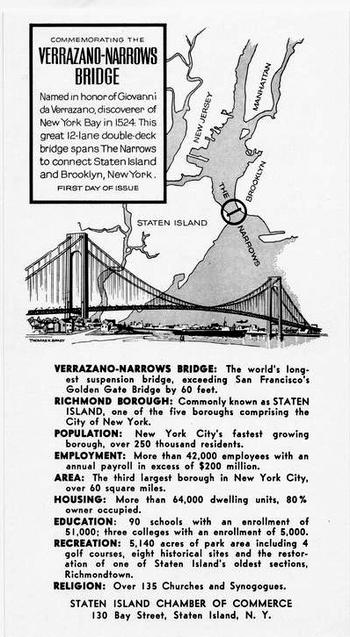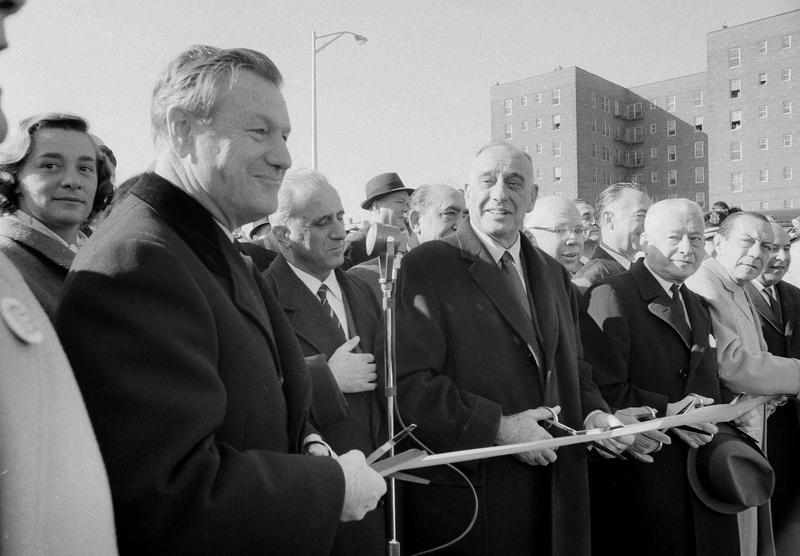 NYPR Archives & Preservation
NYPR Archives & Preservation
The Verrazano-Narrows Bridge, "The Most Princely"
![Verrazano-Narrows Bridge [stamped on back: I went over the Verrazano-Narrows Bridge on opening day November 21, 1964]](https://media.wnyc.org/i/800/0/l/85/1/VerrazanoBridgeAdjusted.jpg)
November 21, 2014 marks the fiftieth anniversary of the opening of the Verrazano-Narrows Bridge. It took much effort and many years for this event to occur, so it is no surprise to hear the awe and admiration in some of the voices who spoke at the opening ceremony: in the audio above you can hear excerpts from Mayor Wagner, Brooklyn Borough President Abe Stark, and Roger Blough, the President of the U.S. Steel Corporation.
In the 1910s and 1920s plans to build vehicular bridges between Staten Island and New Jersey were proposed, as were tunnels between the island and Brooklyn and Manhattan. In 1923, borings for a tunnel under the Narrows that would connect the Fourth Avenue line in Brooklyn with Staten Island were undertaken, but with the arrival of the Great Depression the idea for a subway tunnel was abandoned. Elsewhere on Staten Island connections to New Jersey were realized in 1928 with the Goethals Bridge and the Outerbridge Crossing, while the Bayonne Bridge began accommodating vehicles and pedestrians to Manhattan in 1931. Although more attempts were made to resurrect the proposal for a tunnel under the Narrows, eventually it was forsaken in favor of a suspension bridge.
With the formation of the Triborough Bridge and Tunnel Authority in 1946, the plan for a bridge spanning the Narrows was advanced as the Authority was headed by Robert Moses, a man who disliked tunnels. At this time, and well into the early 1960s, Staten Island’s mid and southern section still held considerable farmland that profited by the available markets in Manhattan. With the announcement that a suspension bridge would truly be built between Brooklyn and Staten Island land prices began to rise. Much to the regret of preservationists the construction of the Brooklyn tower destroyed Fort Lafayette, an historic military outpost built after 1812, but in the late 1950s historic preservation was in its infancy and most people did not want to confront Robert Moses about such “trivial” concerns.
Initially Islanders were not as opposed to the bridge as were the residents of Brooklyn: many hoped the bridge would bring economic expansion that would allow the island to achieve equal footing with the other boroughs. Officially, the Narrows span would serve several purposes, among them spurring industrial growth (which had been floundering on the island since the close of World War II) and circumnavigating traffic away from and around Manhattan, while connecting the southern and northern interstate highway system on the East Coast. The end result, of course, was that the bridge allowed for quick and easy access between Staten Island, New Jersey, Brooklyn, and the remaining boroughs.
Naming the bridge led to numerous arguments. The Italian Historical Society had a lengthy discussion with Moses over the bridge’s moniker. Their proposal was finally accepted by Moses; hence the explorer Giovanni da Verrazzano was honored as he was considered to be the first European to enter what would later be called the New York Harbor.
Ground for the Verrazano Narrows Bridge was broken on August 13, 1959. The men who worked on the bridge referred to themselves as “Iron Workers” even though they worked with steel. Some lived in Brooklyn, while others traveled from one bridge job to another throughout the country. Native Americans from the Caughnawaga Reservation near Montreal, who commuted home on weekends, worked on the project. Three men died during construction. Had under netting been in place some of their deaths might have been averted.
On opening day, November 21, 1964, Mayor Wagner called the Verrazano-Narrows Bridge "the most princely" of bridges, and other officials attending the invitation-only ceremony were equally ecstatic. Designed by Othmar Hermann Ammann, a native of Switzerland, the stupendous bridge towers are 623’ high. The bridge is so vast that the curvature of the earth needed to be considered during its design: for this reason the tops of the towers are 1 5/8” further apart then their bases. The cost to build the bridge was $305 million. In 1969 the lower roadway would open to accommodate the onslaught of traffic that was arriving at the bridge each day. It is still the longest suspension bridge in the United States, and the last large-scale bridge built in the area until construction on the new Tappan Zee bridge started last year.
By 2009, the bridge was generating $1 million every twenty four hours for the Triborough Bridge and Tunnel Authority; travelers can expect a rise in tolls in 2015. Currently, fifteen dollars is required on the Staten Island side of the crossing. With E-Z Pass the charge is six dollars and thirty six cents. Three or more trips in one month decreases the cost by a few nickels. The upcoming toll increase is deemed horrific to most Staten Island residents as was the arrival of numerous Brooklyn transplants after “The Bridge” opened... But that, of course, is another story.
Additional info:
Complete Verrazano Narrows Bridge Opening Ceremony

